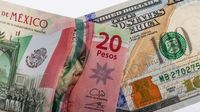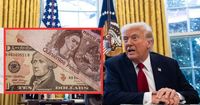On March 27, 2025, the Mexican peso faced significant challenges as it traded at an interbank exchange rate of 20.17 pesos per dollar, marking a 0.35% increase from the previous day. This fluctuation comes amid growing concerns over new tariffs announced by the United States, which are set to take effect next week. Investors are closely monitoring developments that could influence currency markets, reflecting a climate of uncertainty.
The average exchange rate for the dollar in Mexico today shows a buying price of 19.66 pesos and a selling price of 20.46 pesos. Various banks reported differing rates, with Banco Azteca offering a buying price of 19.15 pesos and a selling price of 20.59 pesos, while Banorte's rates were 18.85 pesos for buying and 20.45 pesos for selling.
In a broader context, the dollar index, which measures the value of the U.S. dollar against a basket of currencies, stood at 104.49, reflecting a slight decrease of 0.15% from the previous day. This drop is attributed to the recent announcement of a 25% tariff on imported automobiles by President Donald Trump, which is expected to impact trade relations with key suppliers like Mexico, Japan, South Korea, Canada, and Germany.
The automotive sector, which saw the United States import $474 billion in automotive products in 2024, is particularly sensitive to these tariff changes. The implications of these tariffs could lead to increased costs for consumers and potential retaliatory measures from affected countries.
As of early morning on March 27, the dollar was trading at 20.3034 pesos for selling, as reported by Google Finances. This reflects an increase in the range of 0.23-1.14%. The situation is fluid, with the peso showing minor fluctuations as market participants await further clarity on the tariff situation.
In addition to the interbank rates, various banks across Mexico reported their exchange rates for the dollar. BBVA listed a buying price of 19.47 pesos and a selling price of 20.60 pesos, while Citibanamex offered a buying price of 19.49 pesos and a selling price of 20.64 pesos. The Banco de México (Banxico) reported a closing exchange rate of 20.1370 pesos per dollar for the previous day.
The peso's performance today is also influenced by optimism from the Mexican government, led by President Claudia Sheinbaum, who expressed hope for a new agreement with the United States that could stabilize the peso. If negotiations succeed, it could lead to a strengthening of the peso against the dollar.
As the deadline for the tariff pause approaches on April 2, 2025, market analysts are weighing the potential outcomes. The uncertainty surrounding these tariffs has kept investors on edge, leading to a cautious approach in trading.
In the context of the peso's recent performance, it began the day at 20.20 pesos per dollar according to Banxico. The average selling price in banks was reported at 20.39 pesos, with a buying price of 19.25 pesos. Exchange houses in Tamaulipas reported slightly higher selling prices, averaging 20.69 pesos and buying prices of 19.52 pesos.
The fluctuations in the peso's value reflect a complex interplay of domestic economic conditions and international trade dynamics. As businesses and consumers brace for the potential impact of new tariffs, the focus remains on how these developments will shape the economic landscape in the coming weeks.
In summary, the dollar's exchange rate against the peso on March 27, 2025, demonstrates the ongoing volatility in currency markets, driven by geopolitical events and trade policy changes. The situation remains dynamic, with both risks and opportunities for investors and consumers alike.









